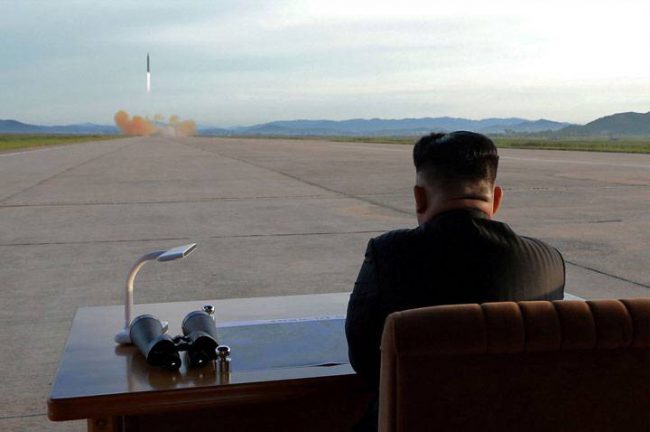North Korea‘s recent announcement that it will cease nuclear weapons and missile testing has been widely welcomed by world leaders, with everyone from the U.S. and European Union to South Korea and Japan hailing it as an encouraging step towards the denuclearization of the Korean Peninsula.

U.S. President Donald Trump, who is expected to meet North Korean Supreme Leader Kim Jong-Un in the coming months, led the symphony of approvals, touting the announcement as a sign of “big progress” in the quest to disarm the North and Kim, or “Rocket Man” as Trump has previously labelled him.
“Wow, we haven’t given up anything & they have agreed to denuclearization (so great for World), site closure, & no more testing!” Trump tweeted on Sunday.
South Korea’s presidential Blue House also invoked the word “progress” in its official reaction, with the country’s president Moon Jae-in telling reporters that he believed the North was “expressing a will for complete denuclearization.”
READ MORE: Trump hails North Korean announcement about ending nuclear, missile tests
However, a close examination of North Korea’s statement reveals no intentions whatsoever to give up its nuclear weapons program, or do away with its existing arsenal. Rather, it only talks about a freeze in the testing of nuclear warheads and ballistic missiles — not in arms production or other areas of weapons infrastructure development.
In fact, the announcement states that North Korea is ceasing testing because it has achieved its goals in building up its core nuclear weapons capabilities and taking its place among the world’s nuclear-armed states.

Kim’s statement went on to praise the North Korean people for coping with years of belt-tightening measures that helped enable the country’s acquisition of “a powerful treasured sword for defending peace.”
He also assured that his government will now direct its energies towards “building a powerful socialist economy and markedly improving the standard of people’s living through the mobilization of all human and material resources of the country.”
READ MORE: CIA Director Mike Pompeo recently met with Kim Jong Un in North Korea
North Korea may have a history of spouting bluster and often outrageous propaganda, but experts say there’s no reason not to take Kim’s bold claims about his country’s weapons capabilities at face value.
“I’m not going to doubt them on that… if we keep doubting their capabilities, they’ll be happy enough to show them to us,” said Ankit Panda, a security analyst and senior adjunct fellow with the Federation of American Scientists.
Panda told Global News all indications are that the North’s ramped-up schedule of nuclear weapons development over the past few years has borne fruit.
WATCH: North Korea claims to have carried out hydrogen bomb test

Panda points out that the September 2017 test was measured as the largest man-made explosion on Earth in 25 years, since China’s underground nuclear device test in 1992.
Not even India and Pakistan, who barged into the nuclear weapons club within days of each other in 1998, have that capability.
Panda says a comparison between North Korea and the two South Asian neighbours is instructive because both those countries conducted the same number of nuclear tests that North Korea has — six — before being recognized as nuclear powers.
However, while the Indian and Pakistani nuclear weapons programs prioritized precision over power — because their primary strategic threats are their next-door neighbours — North Korea has a different focus.
“The North Koreans had a much more significant objective with their thermonuclear bomb test… they have to threaten large American cities with relatively inaccurate weapons,” Panda said. “When you have inaccurate missiles at long ranges, you can compensate for a lack of accuracy by having larger yields.”
READ MORE: North Korea could launch nuclear strike on Britain by summer
With high-yield nuclear weapons seemingly in the bag or close to it, the North can focus on other areas of need, such as adding to its current fleet of six launch vehicles, Panda said.
“If you only have six launchers, it doesn’t matter how many missiles you can manufacture. If you can’t physically launch them, they’re not much good. They could launch them from fixed silos or launch sites, but then they’re easy to track and easy for the U.S. to destroy in a strike. So road mobility is important for them.”
Another area of focus could be the modernizing of the North’s nuclear command and control infrastructure, of which Panda says “we don’t know a lot about, but it’s probably still quite rudimentary.”
WATCH: North Korean propaganda video puts White House in crosshairs, depicts strike on US Capitol

However, much of Kim’s proclamation touched on what he said will be a renewed effort to uplifting the country’s economy. That too is in his best interest, according to Jean Lee, director of the Korea program at the Washington, D.C.-based Wilson Center.
Lee says Kim recognizes the importance of placating a North Korean populace who have lived in desperate poverty while watching their regime pursue an expensive nuclear program that has strained the national budget, and brought with it crippling sanctions.
“It’s his way of saying, ‘I spent this money on the nuclear program and it’s accomplished what I wanted, which is to show you that I can defend you and earn our spot among world leaders of nuclear-armed countries… and now I’m ready to direct my attention towards building the economy.’
“There were two things Kim had to do to solidify his position as leader… one was to establish himself as a military leader capable of defending his people. He feels like he has done that, but he knows he’s not going to be able to hold onto support unless he also improves the lives of the North Korean people, because they’re going without basic necessities such as power, heat, food and clean water,” said Lee, who in 2012 opened the first ever U.S. news bureau in Pyongyang for the Associated Press.
“This is Kim Jong-Un positioning himself, particularly before he goes into the summit with the South Korean president later this week, and of course before he goes into the anticipated summit with President Donald Trump in the coming months.”
READ MORE: North, South Korea connect hotline between leaders ahead of rare summit
The inter-Korean summit, set for Friday Apr. 27, will likely be marked by Kim attempting to make a strong show of Korean unity, and open the doors to reuniting families separated by the Korean War.
“This is something that has been integral to North Korean identity, which is to show a kind of pan-Korean identity across the peninsula that will help him reinforce the propaganda back home that he is a leader who can bring about reconciliation or reunification,” Lee said.
Also on the agenda will be discussions on bringing a close to the Korean War, which ceased in an armistice in 1953 but never officially ended, with the U.S. still maintaining over 23,000 troops on South Korean soil.
“That’s something that North Korea will also have to negotiate with the United States, so they will perhaps discuss that and look to set the stage,” Lee said.
READ MORE: North, South Korea reportedly discussing plan to announce end of war following summit
Kim won’t be the only one to gain from the summits, however, as both the U.S. and South Korea are also politically invested in engaging with him.
“The Moon government has been pro-engagement from day one… for them, it’s really important to point to anything that can be interpreted as a gesture of goodwill from North Korea,” Panda said.
Indeed Trump’s ambassador to the United Nations, Nikki Haley, hinted that the North’s new-found openness towards the U.S. and South Korea was proof of the success of the American-led UN effort.
“You can see the Security Council really came together and was able to enforce sanctions on North Korea, isolate them until they had good behaviour, and now we’re seeing they’re wanting to come to the table,” Haley told reporters Saturday.
WATCH: Trump hopes for ‘huge success’ in Kim Jong Un meeting

However, the biggest winner looks to be Kim himself, with Panda stating that Trump’s tweet about looking forward to the summit will likely come as music to Kim’s years.
“A summit with a U.S. president in itself is a huge, huge win for the North Koreans. So Kim had a lot of incentives to give up as much as he can upfront just to get Trump in a room with him for a summit,” Panda said.
“A lot of observers pointed to an ICBM freeze as one of the outcomes of the summits, but now North Korea has gone ahead and given that to us upfront.”
In other words, for Kim, the opportunity to sit across from an American president on a near-equal footing — as the head of a nuclear-armed state — is well worth freezing missile tests for a few years, especially considering that the North will still be free to pursue other areas of weapons infrastructure development.
READ MORE: How did North Korea get nuclear weapons?
The manner in which Kim has played his hand marks him out as a more brash leader than his father Kim Jong-Il, according to Lee, who closely reported on the elder Kim’s death in 2011.
“I think he’s proving to be very different from his father — who was extremely secretive — and he’s also proving to be somewhat of a master strategist,” Lee said. “There’s no denying that he has played this situation well over the last couple of years.”

It was over half a century ago that North Korea’s founding father Kim Il-Sung began to lay the groundwork for his country’s nuclear weapons program, the scars of the Korean War fresh in his mind.
His son Kim Jong-Il would go on to oversee the evolution of the nuclear program from a distant dream to a realistic target, the country’s first two nuclear weapons tests happening under his watch.
But it is third-generation leader Kim Jong-Un who is set to go down as the first leader of a nuclear-armed North Korea. And he wants the world to know.




Comments